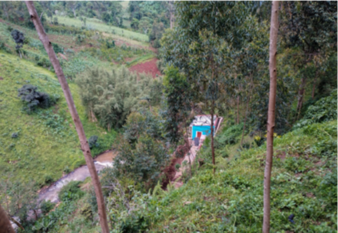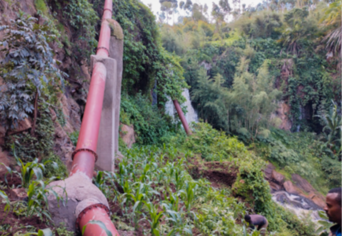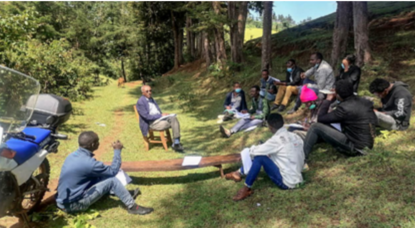Knowledge fuels change - Support energypedia!
For over 10 years, energypedia has been connecting energy experts around the world — helping them share knowledge, learn from each other, and accelerate the global energy transition.
Today, we ask for your support to keep this platform free and accessible to all.
Even a small contribution makes a big difference! If just 10–20% of our 60,000+ monthly visitors donated the equivalent of a cup of coffee — €5 — Energypedia would be fully funded for a whole year.
Is the knowledge you’ve gained through Energypedia this year worth €5 or more?
Your donation keeps the platform running, helps us create new knowledge products, and contributes directly to achieving SDG 7.
Thank you for your support, your donation, big or small, truly matters!
Rehabilitation of Micro-Hydropower Plants in Ethiopia
Rehabilitation of Micro-Hydropower Plants in Ethiopia
Project Approach
Ethiopia is still facing substantial challenges in increasing access to electricity despite the country having huge renewable energy potential in hydropower, solar, and wind energy. The National Electrification Program 2.0 features mini-grids as short-term electrification solutions for areas that are relatively close to the national grid and as mid-term solutions for areas that are further away and less accessible. Against this background, the Green People´s Energy (Grüne Bürgerenergie, GBE) project supports the rehabilitation of microhydropower plants (MHP) and their respective mini-grid structures. The project works with energy cooperatives in the Sidama region, that had previously been supported in the installation of MHP by the Energising Development (EnDev) programme of GIZ. The cooperatives have been operating the MHP mini-grids and supplying power to their respective communities since 2010. The MHP use water resources through small run-of-river hydroelectric plants with a capacity of less than 40 KW to generate electricity and distribute it to nearby households through mini-grids. However, at the beginning of the GBE project, only one MHP-mini-grid was found to be still operating, while the rest of the MHP-mini-grids were not fully functional anymore.
The project approach started with a detailed needs assessment of the MHP sites and the distribution grid. Through a context analysis, technical- and management problems of the past were analysed. Afterwards, the project addresses the identified challenges with tailor-made training and support for the energy cooperatives, with the aim to restructure and clarify roles, tasks, and responsibilities. The project measures include i) revising and optimising the organisational set-up of the cooperatives; ii) revision of the business plan and business management; iii) enhancing the cooperatives’ Operation and Maintenance (O&M) system for MHP and mini-grids. Moreover, the project supports the cooperatives to design a new tariff model and revenue collection scheme to sustainably manage and finance the mini-grid operation – and even connect new customers to the MHP mini-grids. In addition, the project finances the technical rehabilitation of the micro-hydropower plants by covering the costs of the civil engineering works, the electro-mechanical works and equipment, as well as training of management members and the operators of the MHP. As the end-users’ own contribution (in kind) is key to promoting ownership, members of the energy co-operatives are assisting with the construction work by preparing the access road to the sites, helping to transport the structures down the steep slopes and providing other labour support where needed.
The Regional Energy Bureau (REB) and the Woreda Energy Office (WEO) and energy cooperatives are strongly involved in the project and participate in the training, as they keep having an important supporting- and overseeing role beyond the assignment.
Key Findings
Project Achievements
Drawing from its experience from its prior works towards improving the regulatory framework for energy cooperatives on the national level, the project took a deep dive into the actual MHP energy cooperatives to review the cooperatives’ setup and management structure as well as their interaction with local government bodies and the private sector.
Moreover, a revised organisational set-up including membership-, management- and board structure with revised roles, tasks, and responsibilities was developed together withto the energy coopetatives. Various members of the cooperatives have participated in this training and now understand better what they could change in their management systems and internal regulations to run the energy cooperatives smoothly and efficiently. For instance, the need to collect fees from mini-grid users without favouring the relatives of cooperative managers or anyone else was recognised as an important factor. In addition, in future, the cooperatives are going to monitor the collection of the fees and ensure that they are paid on time. Furthermore, cooperatives have acknowledged that collected fees should be used to ensure preventive and curative maintenance of the MHP and the mini-grids.
In addition, GBE together with the cooperatives has developed a revised tariff structure based on the number of electrical appliances used and a revised monthly revenue fee collection scheme. Furthermore, GBE elaborated a business plan for the energy cooperatives with an operational plan for the management and maintenance of the MHP and the mini-grids.
At the beginning of the project, key parts of the MHP were dysfunctional and needed to be repaired or replaced to generate electricity. The project has completed civil work for two MHP sites: Agara Sodicho and Gobecho. The civil work includes the construction of a water intake, control gate, and penstock. In addition, the electro-mechanical work will be completed soon, covering the installation of a turbine and generator, an electric resonance, and a control unit.
Methodology of Data Collection
Data for this case study report was collected through a review of project documents, four qualitative interviews with representatives of the Ministry of Water and Energy (MoWE), representatives of GIZ, Sidama Energy Bureau and Sidama Cooperative Bureau, as well as two focus group discussions with Agara Sodicho Cooperative and Gobecho Cooperative. The case study was conducted between May 2023 and July 2023. At that time, some project activities were still ongoing. Accordingly, the effects captured are not exhaustive.
Intermediate Impact
At the time of the case study, the MHP (anticipated capacity of Agera Sodicho 35KW and Gobecho 24KW) are not operational yet. However, the following future impacts can be anticipated: Once the MHP are operational (again), the community households (up to 350 end-users at Agera Sodicho and up to 125 at Gobecho) could benefit from the electricity and related improvements in quality of life. For example, electricity can replace the use of candles or conventional fuels (for example kerosene or butane) for lighting. Access to electricity would enable the local population to power appliances for increasing or diversifying their local production, and it would also ease the access to communication services and media. In addition, once MHP are adequately operational and providing power to communities, they will serve as a business case for the development of other hydropower sites. Both local communities and institutional partners such as woredas, regional states and federal ministries could use this business case as a model for new mini-grid systems powered by MHP.
Cooperatives themselves have recognised the importance of improved structures and processes. The project achievements described above can lead to a more effective, efficient and transparent management of the MHP in the long-term.
Climate Impacts
Following the calculation methodology of the United Nations Framework Convention on Climate Change (UNFCCC), the installations described above are estimated to mitigate 45,7tCO2e/a in the year of installation by avoiding and/or replacing the use of fossil fuels. This is roughly equivalent to the annual CO2 emissions of more than 32 medium-sized cars in Germany. However, it has to be noted that these installations were not completed at the time of data collection.
Challenges in Project Implementation
A third cooperative, the Ererte cooperative, was originally also expected to benefit from the project. However, the rehabilitation of the MHP was finally not possible, because the costs of civil work (price of steel, cement) and electro-mechanical devices for the MHP, went up substantially between 2020 and 2022 due to challenging macroeconomic factors including significant inflation. Eventually, the project budget was sufficient to only cover the two MHP sites Agara Sodicho and Gobecho. However, the project provided capacity building and trainings to the third cooperative as well. Therefore, the Erete energy cooperative could capitalise on the knowledge gained and work to identify and leverage funding from either commercial, public or development-cooperation sources to pay for the technical rehabilitation of its MHP.
The expectations of the supported cooperatives went beyond the scope of the project. They expected to have larger capacities installed and to electrify more community members. On the Gobecho site, the energy cooperative was expecting higher capacity than 24KW and an extension of the mini-grid to cover not all households of the entire community as well as social facilities such as a health centre, which so far operates a solar-PV powered fridge for medicine and vaccines. However, this wouldn’t have been possible given the available project funds in combination with the aforementioned increase of prices for material and services. At the same time, the REB and the WEO were expecting in-depth and multi-month training on the operation and maintenance of the MHP. Nevertheless, the implementer has explained to the stakeholders that GBE is supporting pilot projects to showcase a new management approach of the energy cooperatives operating MHP, and that involved parties could use the knowledge and expertise gained to scale up the projects and eventually replicate them at other potential MHP sites.
In addition, the energy skills base in rural Ethiopia is limited and challenging. The project had to make a major effort to train members of the energy cooperatives, starting with the basics and providing a refresher training to ensure that the trainees retain the knowledge. Project implementation was delayed due to the Covid-19 pandemic; many coordination meetings with REBs and the MoWE were postponed. Furthermore, and due to several economic challenges in the country, the electromechanical equipment had to be imported from abroad. This led to delays in the procurement process, as time was needed to complete customs procedures next to identifying suppliers. This also resulted in high equipment costs.
Lessons Learned
The conducted capacity buildings were very relevant not only to addressing the limitations and failures in the previous management of the energy cooperatives but also to energising and motivating beneficiaries.The project successfully started the civil works after providing training and tailor-made support. The energy cooperatives contributed to the labour force for civil works, which is important for raising awareness among their members and creating ownership of the project.
In view of the challenges described above, adequate expectation management and early procurement of the necessary equipment are important success factors for similar projects. Moreover, cooperatives are to work closely together with specialized private sector companies, who should take over any complicated and/or dangerous service & maintenance works on an ad-hoc- or framework-contract base.
Another technical lesson is that complementary power generation with solar-PV is nowadays a technically less complicated and less costly option, and may be considered for further expansion of the present systems or the establishment of future mini-grids in the area.
Lastly, the establishment of an institutionalized, permanent support structure around the cooperatives is key, as cooperatives’ management- and board-members may leave on good or bad terms, which may have implications on the handover of valuable knowledge and experience. Therefore, regional and / or local government structures play an important role in handholding and continuously coaching the cooperatives regarding the sustainable operation and management of the MHP and mini-grids.
Sustainability of the Intervention
The cooperatives have recognised the importance of regular maintenance for sustainable use of the MHP. Improved structures and processes (see project achievements above) will contribute to better maintenance of the MHP once they are operational. In addition, stakeholders have recognised the need to have spare parts available in case the MHP need repair. GBE has financed the purchase of some needed spare parts, that are either stored at the premises of the energy cooperatives or at the MoWE offices in Addis Ababa. These parts will be used to repair the MHP when needed.
Moreover, a refresher training and coaching has taken place in June 2023 to consolidate the acquisition of knowledge and its use by the energy cooperatives in the long term. For the long term sustainability, however, the strong commitment of representatives from the Sidama REB, the Sidama Cooperative Bureau and the WEO is important, and they have a strong motivation to support the energy cooperatives in the successful operation of the MHP. For the sake of creating an institutionalized local support structure, GBE has deliberately invited participants from the REB and the WEO to the trainings as they will accompany the cooperatives to ensure the sustainability of the training outcomes and to disseminate the knowledge gained from the training to cooperative members not attending the training.
Conclusion and Outlook
The intervention supported the energy cooperatives by improving the management structures and processes, taking current needs and shortfalls of the past into consideration. The extent to which the rehabilitated MHP will operate successfully once construction is complete cannot be assessed at this stage. The REB and the WOE have gained substantial knowledge and could accompany other energy cooperatives that run MHP but were not part of the group of the GBE intervention. There is a commitment from the REB to replicate the rehabilitation and training of the energy cooperatives. However, this is constrained by the limited funding available. Another option for future projects is to expand the capacity of existing MHP, possibly by adding solar PV as complementary and additional power generation. If the energy generated is used productively, additional income opportunities could be created for the communities.























